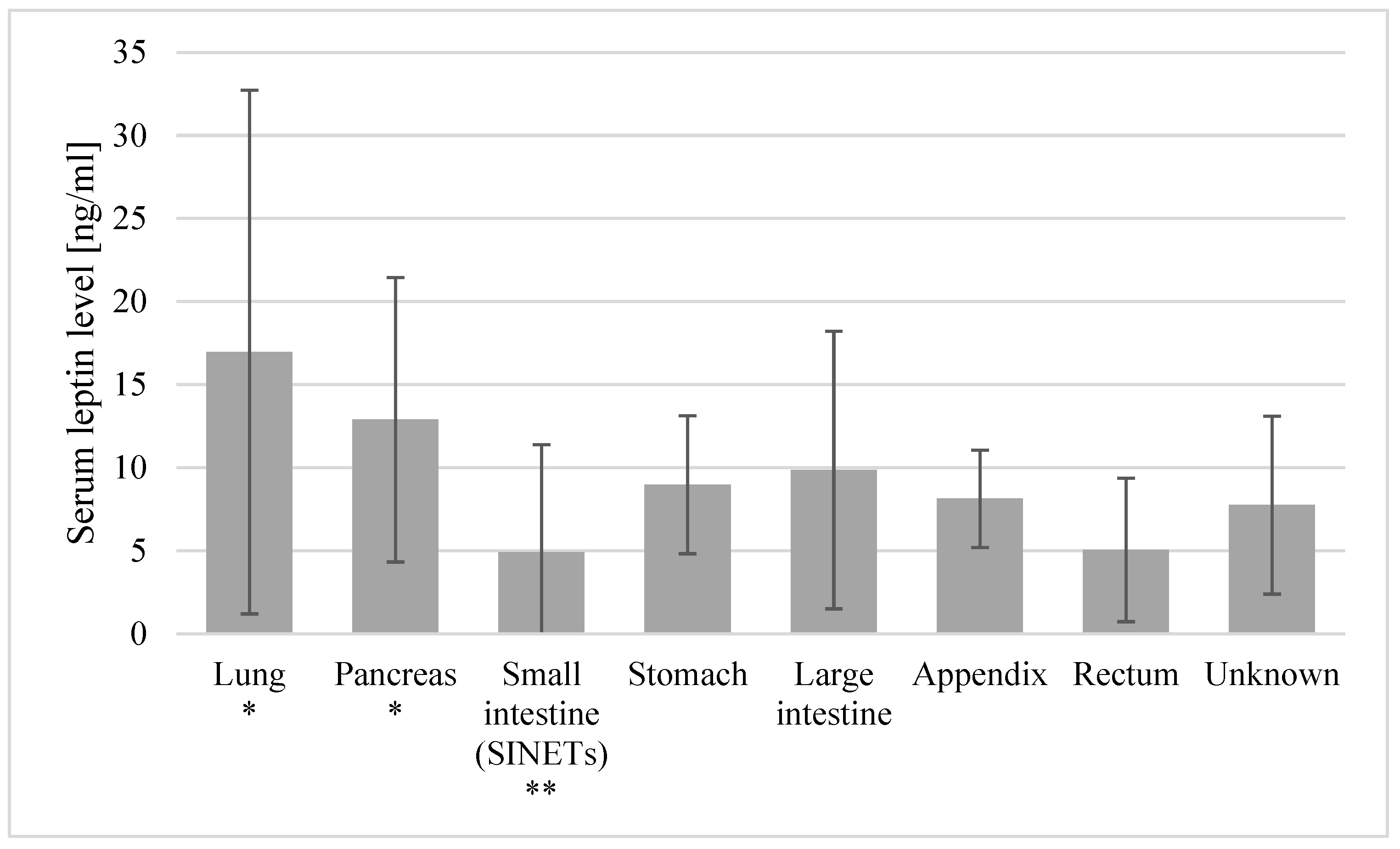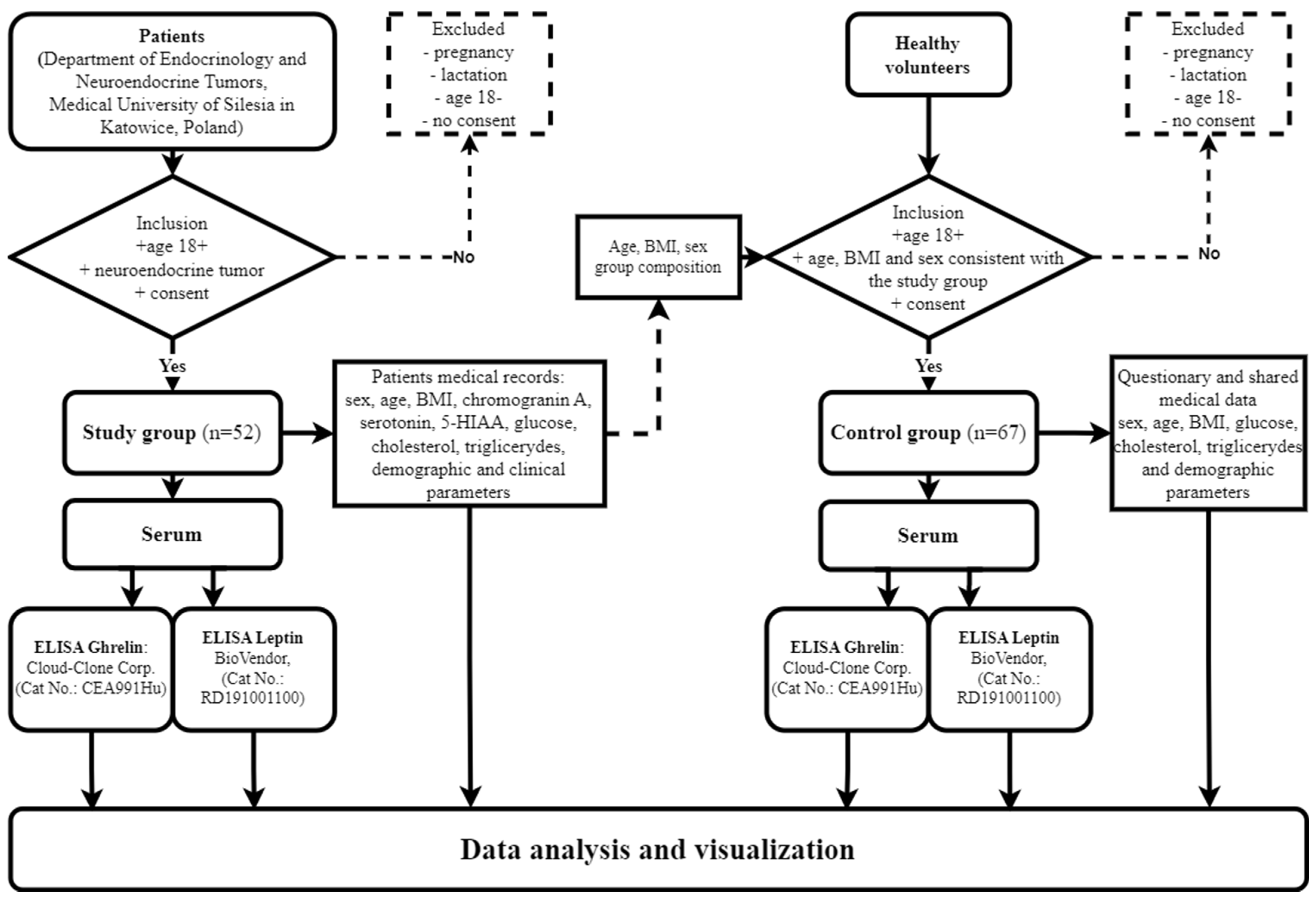Adipokines in Neuroendocrine Tumors: An Evaluation of the Serum Levels of Ghrelin and Leptin
Abstract
:1. Introduction
2. Results
2.1. The Study and Control Cohorts
2.2. Ghrelin
2.3. Leptin
2.4. Other Demographic, Clinical and Biochemical Parameters in the Study Group
3. Discussion
4. Materials and Methods
4.1. The Study Group and the Controls
4.2. Enzyme-Linked Immunosorbent Assay (ELISA)
4.3. Statistical Analysis
5. Conclusions
Limitations
Author Contributions
Funding
Institutional Review Board Statement
Informed Consent Statement
Data Availability Statement
Acknowledgments
Conflicts of Interest
References
- Foltyn, W.; Malczewska, A.; Bednarczuk, T.; Bolanowski, M.; Chmielik, E.; Gisterek, I.; Hubalewska-dydejczyk, A.; Junik, R.; Kajdaniuk, D.; Kowalska, A.; et al. Update of the Diagnostic and Therapeutic Guidelines for Gastro-Entero-Pancreatic Neuroendocrine Neoplasms (Recommended by the Polish Network of Neuroendocrine Tumours). Endokrynol. Pol. 2022, 73, 387–454. [Google Scholar] [CrossRef]
- Pavel, M.; Öberg, K.; Falconi, M.; Krenning, E.P.; Sundin, A.; Perren, A.; Berruti, A. Gastroenteropancreatic Neuroendocrine Neoplasms: ESMO Clinical Practice Guidelines for Diagnosis, Treatment and Follow-Up. Ann. Oncol. 2020, 31, 844–860. [Google Scholar] [CrossRef]
- WHO Classifications of Tumours Online. Available online: https://tumourclassification.iarc.who.int/welcome/ (accessed on 22 July 2024).
- Herrera-Martínez, Y.; Teomiro, C.A.; Idougourram, S.L.; Puertas, M.J.M.; Continente, A.C.; Blanch, R.S.; Castaño, J.P.; Moreno, M.Á.G.; Gahete, M.D.; Luque, R.M.; et al. Sarcopenia and Ghrelin System in the Clinical Outcome and Prognosis of Gastroenteropancreatic Neuroendocrine Neoplasms. Cancers 2022, 14, 111. [Google Scholar] [CrossRef]
- Kojima, M.; Hosoda, H.; Date, Y.; Nakazato, M.; Matsuo, H.; Kangawa, K. Ghrelin Is a Growth-Hormone-Releasing Acylated Peptide from Stomach. Nature 1999, 402, 656–660. [Google Scholar] [CrossRef]
- Shinsyu, A.; Bamba, S.; Kurihara, M.; Matsumoto, H.; Sonoda, A.; Inatomi, O.; Andoh, A.; Takebayashi, K.; Kojima, M.; Iida, H.; et al. Inflammatory Cytokines, Appetite—Regulating Hormones, and Energy Metabolism in Patients with Gastrointestinal Cancer. Oncol. Lett. 2020, 20, 1469–1479. [Google Scholar] [CrossRef]
- Delhanty, P.J.D.; Neggers, S.J.; Van Der Lely, A.J. Mechanisms in endocrinology: Ghrelin: The Differences between Acyl- and Des-Acyl Ghrelin. Eur. J. Endocrinol. 2012, 167, 601–608. [Google Scholar] [CrossRef]
- Andrews, Z.B. Ghrelin: What’s the Function? J. Neuroendocrinol. 2019, 31, e12772. [Google Scholar] [CrossRef]
- Polińska, B.; Matowicka-karna, J.; Kemona, H. Rola Greliny w Organizmie (The Role of Ghrelin in the Organism). Postep. Hig. Med. Dosw. 2011, 65, 1–7. [Google Scholar] [CrossRef]
- Friedman, J. The Long Road to Leptin. J. Clin. Investig. 2016, 126, 4727–4734. [Google Scholar] [CrossRef]
- Paz-Filho, G.; Mastronardi, C.A.; Licinio, J. Leptin Treatment: Facts and Expectations. Metab. Clin. Exp. 2015, 64, 146–156. [Google Scholar] [CrossRef]
- Nowak, A.; Kobierzycki, C.; Dzięgiel, P. Rola Leptyny W Patogenezie Nowotworów Związanych Z Otyłością. Postępy Biol. Komórki 2015, 42, 309–328. [Google Scholar]
- Ray, A.; Cleary, M.P. The Potential Role of Leptin in Tumor Invasion and Metastasis. Cytokine Growth Factor Rev. 2017, 38, 80–97. [Google Scholar] [CrossRef]
- Tourkantonis, I.; Kiagia, M.; Peponi, E.; Tsagouli, S.; Syrigos, K.N. The Role of Leptin in Cancer Pathogenesis. J. Cancer Ther. 2013, 4, 640–650. [Google Scholar] [CrossRef]
- Akalu, Y.; Molla, M.D.; Dessie, G.; Ayelign, B. Physiological Effect of Ghrelin on Body Systems. Int. J. Endocrinol. 2020, 2020, 1385138. [Google Scholar] [CrossRef]
- Volante, M.; Allìa, E.; Gugliotta, P.; Funaro, A.; Broglio, F.; Deghenghi, R.; Muccioli, G.; Ghigo, E.; Papotti, M. Expression of Ghrelin and of the GH Secretagogue Receptor by Pancreatic Islet Cells and Related Endocrine Tumors. J. Clin. Endocrinol. Metab. 2002, 87, 1300–1308. [Google Scholar] [CrossRef]
- Lin, T.; Hsiao, M. Biochimica et Biophysica Acta Ghrelin and Cancer Progression. BBA-Rev. Cancer 2017, 1868, 51–57. [Google Scholar] [CrossRef]
- Soleyman-Jahi, S.; Abdirad, A.; Fallah, A.A.; Ghasemi, S.; Sadeghi, F.; Heidari, R.; Mahmoodzadeh, H.; Zendehdel, K. Prognostic Significance of Preoperative and Postoperative Plasma Levels of Ghrelin in Gastric Cancer: 3-Year Survival Study. Clin. Transl. Gastroenterol. 2017, 8, e209. [Google Scholar] [CrossRef]
- Korbonits, M.; Bustin, S.A.; Kojima, M.; Jordan, S.; Adams, E.F.; Lowe, D.G.; Kangawa, K.; Grossman, A.B. The Expression of the Growth Hormone Secretagogue Receptor Ligand Ghrelin in Normal and Abnormal Human Pituitary and Other Neuroendocrine Tumors. J. Clin. Endocrinol. Metab. 2001, 86, 881–887. [Google Scholar] [CrossRef]
- Grönberg, M.; Nilsson, C.; Markholm, I.; Hedenfalk, I.; Blomqvist, C.; Holmberg, L.; Janson, E.T.; Fjällskog, M. Ghrelin Expression Is Associated with a Favorable Outcome in Male Breast Cancer. Sci. Rep. 2018, 8, 13586. [Google Scholar] [CrossRef]
- Zhu, C.; Liu, Y.; Kang, W.; Zhang, Z.; Zeng, Z.; Liu, D. Exploration of the Role of Serum Ghrelin in the Diagnosis and Treatment of Digestive Tract Malignancies. J. Int. Med. Res. 2020, 48. [Google Scholar] [CrossRef]
- Papotti, M.; Cassoni, P.; Volante, M.; Deghenghi, R.; Muccioli, G.; Ghigo, E. Ghrelin-Producing Endocrine Tumors of the Stomach and Intestine. J. Clin. Endocrinol. Metab. 2001, 86, 5052–5059. [Google Scholar] [CrossRef]
- Grönberg, M.; Tsolakis, A.V.; Holmbäck, U.; Stridsberg, M.; Grimelius, L.; Janson, E.T. Ghrelin and Obestatin in Human Neuroendocrine Tumors: Expression and Effect on Obestatin Levels after Food Intake. Neuroendocrinology 2013, 97, 291–299. [Google Scholar] [CrossRef]
- Luque, R.M.; Sampedro-nuñez, M.; Gahete, M.D.; Ramos-levi, A.; Ibáñez-Costa, A.; Rivero-Cortés, E.; Serrano-Somavilla, A.; Adrados, M.; Culler, M.D.; Castaño, J.P.; et al. In1-Ghrelin, a Splice Variant of Ghrelin Gene, Is Associated with the Evolution and Aggressiveness of Human Neuroendocrine Tumors: Evidence from Clinical, Cellular and Molecular Parameters. Oncotarget 2015, 6, 19619–19633. [Google Scholar] [CrossRef]
- Herrera-Martínez, A.D.; Gahete, M.D.; Sánchez-Sánchez, R.; Alors-Perez, E.; Pedraza-Arevalo, S.; Serrano-Blanch, R.; Martínez-Fuentes, A.J.; Gálvez-Moreno, M.A.; Castaño, J.P.; Luque, R.M. Ghrelin-O-Acyltransferase (GOAT) Enzyme as a Novel Potential Biomarker in Gastroenteropancreatic Neuroendocrine Tumors. Clin. Transl. Gastroenterol. 2018, 9, e196. [Google Scholar] [CrossRef]
- Herrera-Martínez, A.D.; Gahete, M.D.; Sánchez-Sánchez, R.; Salas, R.O.; Serrano-Blanch, R.; Salvatierra, Á.; Hofland, L.J.; Luque, R.M.; Gálvez-Moreno, M.A.; Castaño, J.P. The Components of Somatostatin and Ghrelin Systems Are Altered in Neuroendocrine Lung Carcinoids and Associated to Clinical-Histological Features. Lung Cancer 2017, 109, 128–136. [Google Scholar] [CrossRef]
- Spiridon, I.A.; Gabriela, D.; Ciobanu, A.; Giușcă, S.E.; Căruntu, I.D. Ghrelin and Its Role in Gastrointestinal Tract Tumors (Review). Mol. Med. Rep. 2021, 24, 663. [Google Scholar] [CrossRef]
- Van Adrichem, R.C.S.; Van Der Lely, A.J.; Huisman, M.; Kramer, P.; Feelders, R.A.; Delhanty, P.J.D.; de Herder, W.W. Plasma Acylated and Plasma Unacylated Ghrelin: Useful New Biomarkers in Patients with Neuroendocrine Tumors? Endocr. Connect. 2016, 5, 143–151. [Google Scholar] [CrossRef]
- Corbetta, S.; Peracchi, M.; Cappiello, V.; Lania, A.; Lauri, E.; Vago, L.; Beck-Peccoz, P.; Spada, A. Circulating Ghrelin Levels in Patients with Pancreatic and Gastrointestinal Neuroendocrine Tumors: Identification of One Pancreatic Ghrelinoma. J. Clin. Endocrinol. Metab. 2003, 88, 3117–3120. [Google Scholar] [CrossRef]
- Vu, J.P.; Wang, H.S.; Germano, P.M.; Pisegna, J.R. Ghrelin in Neuroendocrine Tumors. Peptides 2011, 32, 2340–2347. [Google Scholar] [CrossRef]
- Tsolakis, A.V.; Portela-Gomes, G.M.; Stridsberg, M.; Grimelius, L.; Sundin, A.; Eriksson, B.K.; Öberg, K.E.; Janson, E.T. Malignant Gastric Ghrelinoma with Hyperghrelinemia. J. Clin. Endocrinol. Metab. 2004, 89, 3739–3744. [Google Scholar] [CrossRef]
- Chauhan, A.; Ramirez, R.A.; Stevens, M.A.; Burns, L.A.; Woltering, E.A. Transition of a Pancreatic Neuroendocrine Tumor from Ghrelinoma to Insulinoma: A Case Report. J. Gastrointest. Oncol. 2015, 6, E34–E36. [Google Scholar] [CrossRef]
- Wang, H.S.; Oh, D.S.; Ohning, G.V.; Pisegna, J.R. Elevated Serum Ghrelin Exerts an Orexigenic Effect That May Maintain Body Mass Index in Patients with Metastatic Neuroendocrine Tumors. J. Mol. Neurosci. 2007, 33, 225–231. [Google Scholar] [CrossRef] [PubMed]
- Ni, J.; Zhang, L. Cancer Cachexia: Definition, Staging, and Emerging Treatments. Cancer Manag. Res. 2020, 12, 5597–5605. [Google Scholar] [CrossRef] [PubMed]
- Wolf, I.; Sadetzki, S.; Kanety, H.; Kundel, Y.; Pariente, C.; Epstein, N.; Oberman, B.; Catane, R.; Kaufman, B.; Shimon, I. In Breast and Colon Cancer Patients. Cancer 2006, 106, 966–973. [Google Scholar] [CrossRef] [PubMed]
- Khatib, M.N.; Shankar, A.H.; Kirubakaran, R.; Gaidhane, A.; Gaidhane, S.; Simkhada, P.; Quazi, S.Z. Ghrelin for the Management of Cachexia Associated with Cancer. Cochrane Database Syst. Rev. 2018, 2018, CD012229. [Google Scholar] [CrossRef]
- Neary, N.M.; Small, C.J.; Wren, A.M.; Lee, J.L.; Druce, M.R.; Palmieri, C.; Frost, G.S.; Ghatei, M.A.; Coombes, R.C.; Bloom, S.R. Ghrelin Increases Energy Intake in Cancer Patients with Impaired Appetite: Acute, Randomized, Placebo-Controlled Trial. J. Clin. Endocrinol. Metab. 2004, 89, 2832–2836. [Google Scholar] [CrossRef]
- Walter, T.; Chardon, L.; Hervieu, V.; Cohen, R.; Chayvialle, J.A.; Scoazec, J.Y.; Lombard-Bohas, C. Major Hyperghrelinemia in Advanced Well-Differentiated Neuroendocrine Carcinomas: Report of Three Cases. Eur. J. Endocrinol. 2009, 161, 639–645. [Google Scholar] [CrossRef]
- Ekeblad, S.; Lejonklou, M.H.; Grimfjärd, P.; Johansson, T.; Eriksson, B.; Grimelius, L.; Stridsberg, M.; Stålberg, P.; Skogseid, B. Co-Expression of Ghrelin and Its Receptor in Pancreatic Endocrine Tumours. Clin. Endocrinol. 2007, 66, 115–122. [Google Scholar] [CrossRef]
- Nass, R.; Farhy, L.S.; Liu, J.; Pezzoli, S.S.; Johnson, M.L.; Gaylinn, B.D.; Thorner, M.O. Age-Dependent Decline in Acyl-Ghrelin Concentrations and Reduced Association of Acyl-Ghrelin and Growth Hormone in Healthy Older Adults. J. Clin. Endocrinol. Metab. 2014, 99, 602–608. [Google Scholar] [CrossRef]
- Considine, R.V.; Sinha, M.K.; Heiman, M.L.; Kriauciunas, A.; Stephens, T.W.; Nyce, M.R.; Ohannesian, J.P.; Marco, C.C.; McKee, L.J.; Bauer, T.L.; et al. Serum Immunoreactive-Leptin Concentrations in Normal-Weight and Obese Humans. Endocrinol. 1996, 6, 349. [Google Scholar] [CrossRef]
- Bielak, A.; Gryta, J.; Iwan, K.; Janczewska, M.; Kalicka, M.; Krysa, T.; Kolasa, A.; Radziejowska, Z.; Szklarz, M.; Kutermankiewicz, J. Influence of Excessive Body Weight on Cancer Development and Prognosis. Qual. Sport 2023, 9, 88–93. [Google Scholar] [CrossRef]
- Wijas, K.; Szala-Czerwonka, K.; Rejmer, A.; Woś, N.; Rojek, K.; Bednarz, L.; Bialic, K.; Bakalarczyk, R.; Bialic, A.; Majewski, P. Is Breast Cancer a Civilization Disease? Common Components of Type 2 Diabetes and Breast Cancer. J. Educ. Health Sport 2023, 24, 80–86. [Google Scholar] [CrossRef]
- Modzelewska, P.; Chludzińska, S.; Lewko, J.; Reszeć, J. The Influence of Leptin on the Process of Carcinogenesis. Wspolczesna Onkol. 2019, 23, 63–68. [Google Scholar] [CrossRef] [PubMed]
- Brown, K.A.; Scherer, P.E. Update on Adipose Tissue and Cancer. Endocr. Rev. 2023, 44, 961–974. [Google Scholar] [CrossRef] [PubMed]
- Gyun, H.; Woo, S.; An, Y.; Khanal, T.; Ho, G.; Jong, S.; Dal, S.; Chul, Y.; Jung, Y.; Cheon, T.; et al. Leptin Induces CREB-Dependent Aromatase Activation through COX-2 Expression in Breast Cancer Cells. Food Chem. Toxicol. 2017, 106, 232–241. [Google Scholar] [CrossRef]
- Wang, D.; Gao, L.; Gong, K.; Chai, Q.; Wang, G. Increased Serum Leptin Level in Overweight Patients with Colon Carcinoma: A Cross-Sectional and Prospective Study. Mol. Clin. Oncol. 2017, 6, 75–78. [Google Scholar] [CrossRef]
- Ishihara, R.; Mizuno, Y.; Miwa, A.; Hamada, A.; Tsuruta, T.; Wabitsch, M.; Sonoyama, K. Intestinal Epithelial Cells Promote Secretion of Leptin and Adiponectin in Adipocytes. Biochem. Biophys. Res. Commun. 2015, 458, 362–368. [Google Scholar] [CrossRef]
- Hansen, G.H.; Niels-Christiansen, L.L.; Danielsen, E.M. Leptin and the Obesity Receptor (OB-R) in the Small Intestine and Colon: A Colocalization Study. J. Histochem. Cytochem. 2008, 56, 677–685. [Google Scholar] [CrossRef]
- Alavi, K.; Schwartz, M.Z.; Prasad, R.; O’Connor, D.; Funanage, V. Leptin: A New Growth Factor for the Small Intestine. J. Pediatr. Surg. 2002, 37, 327–330. [Google Scholar] [CrossRef]
- Pearson, P.Y.; O’Connor, D.M.; Schwartz, M.Z. Novel Effect of Leptin on Small Intestine Adaptation. J. Surg. Res. 2001, 97, 192–195. [Google Scholar] [CrossRef]
- Kiely, J.M.; Noh, J.H.; Graewin, S.J.; Pitt, H.A.; Swartz-Basile, D.A. Altered Intestinal Motility in Leptin-Deficient Obese Mice. J. Surg. Res. 2005, 124, 98–103. [Google Scholar] [CrossRef]
- Kiely, J.M.; Noh, J.; Pitt, H.A.; Swartz-Basile, D.A. Impaired Intestinal Cell Proliferation and Cell Death in Leptin-Deficient Obese Mice. J. Parenter. Enter. Nutr. 2005, 29, 30–35. [Google Scholar] [CrossRef]
- Bocian-Jastrzębska, A.; Malczewska-Herman, A.; Rosiek, V.; Kos-Kudła, B. Assessment of the Role of Leptin and Adiponectinas Biomarkers in Pancreatic Neuroendocrine Neoplasms. Cancers 2023, 15, 3517. [Google Scholar] [CrossRef] [PubMed]
- Wallace, A.M.; Kelly, A.; Sattar, N.; Mcardle, C.S.; Donald, C.; Wallace, A.M.; Kelly, A.; Sattar, N.; Mcardle, C.S.; Mcmillan, D.C. Circulating Concentrations of “Free” Leptin in Relation to Fat Mass and Appetite in Gastrointestinal Cancer Patients. Nutr. Cancer 2009, 44, 157–160. [Google Scholar] [CrossRef] [PubMed]
- Lambris, J.D. Advances in Experimental Medicine and Biology: Sex and Gender Factors Affecting Metabolic Homeostasis, Diabetes and Obesity; Springer: Cham, Switzerland, 2017; Volume 1043. [Google Scholar]
- Rosiek, V.; Bocian-Jastrzębska, A.; Kos-Kudła, B. Selected Serum Biomarkers (Leptin, Chromogranin A, CA19-9, CEA) in Patients with Pancreatic Neuroendocrine Neoplasm and Associations with Metabolic Syndrome. Cancers 2023, 15, 2348. [Google Scholar] [CrossRef]
- Santos, A.P.; Santos, A.C.; Castro, C.; Raposo, L.; Pereira, S.S.; Torres, I.; Henrique, R.; Cardoso, H.; Monteiro, M.P. Visceral Obesity and Metabolic Syndrome Are Associated with Well-Differentiated Gastroenteropancreatic Neuroendocrine Tumors. Cancers 2018, 10, 293. [Google Scholar] [CrossRef]
- Frazee, E.N.; Nystrom, E.M.; Mcmahon, M.M.; Williamson, E.E.; Miles, J.M. Relationship Between Triglyceride Tolerance, Body Mass Index, and Fat Depots in Hospitalized Patients Receiving Parenteral Nutrition. J. Parenter. Enter. Nutr. 2015, 39, 922–928. [Google Scholar] [CrossRef]
- Ruggeri, R.M.; Altieri, B.; Razzore, P.; Retta, F.; Sperti, E.; Scotto, G.; Brizzi, M.P.; Zumstein, L.; Pia, A.; Lania, A.; et al. Gender-related differences in patients with carcinoid syndrome: New insights from an Italian multicenter cohort study. J. Endocrinol. Investig. 2024, 47, 959–971. [Google Scholar] [CrossRef]
- R Core Team. R: A Language and Environment for Statistical Computing. R Foundation for Statistical Computing. Available online: https://www.r-project.org/ (accessed on 20 February 2024).


| n (% of Patients) | |||
|---|---|---|---|
| BP-NET cases 9 (17.31%) | Location of the primary tumor | Lung | 9 (17.31%) |
| Histological grade | Typical carcinoid (TC) | 6 (11.54%) | |
| Atypical (ATC) | 3 (5.77%) | ||
| GEP-NET cases 43 (82.69%) | Location of the primary tumor | Pancreas | 20 (38.46%) |
| Small intestine (SINETs) | 6 (11.54%) | ||
| Stomach | 5 (9.62%) | ||
| Large intestine | 3 (5.77%) | ||
| Appendix | 3 (5.77%) | ||
| Rectum | 2 (3.85%) | ||
| Unknown | 4 (7.69%) | ||
| Histological grade | NET G1 | 34 (65.38%) | |
| NET G2 | 4 (7.69%) | ||
| NET G3 | 5 (9.63%) | ||
| T | T1 | 26 (50.0%) | |
| T2 | 16 (30.77%) | ||
| T3 | 6 (11.54%) | ||
| T4 | 2 (3.85%) | ||
| Undetermined | 2 (3.85%) | ||
| N | N0 | 37 (71.15%) | |
| N1 | 15 (28.85%) | ||
| M | M0 | 23 (44.23%) | |
| M1 | 29 (55.77%) | ||
| Ki-67 | <20% | 44 (84.62%) (6 BP-NET ATC + 38 GEP-NET) | |
| ≥20% and <55% | 8 (15.38%) (3 BP-NET ATC + 5 GEP-NET) | ||
| Metastasis | Total | 27 (51.92%) | |
| Liver metastases | 22 (42.31%) | ||
| Lymph node metastases | 12 (23.08%) | ||
| Bone metastases | 3 (5.77%) | ||
| Other metastases | 6 (11.54%) | ||
| Parameter | Study Group | Control Group | |
|---|---|---|---|
| n (%) | n (%) | p | |
| Sex [F: female, M: male] | F: 33 (63.46%) M: 19 (36.54%) | F: 31 (46.27%) M: 36 (53.73%) | 0.067 |
| Mean ± SD | Mean ± SD | p | |
| Age [years] | 55.33 ± 11.11 | 54.99 ± 3.59 | 0.087 |
| BMI [kg/m2] | 24.99 ± 3.66 | 24.02 ± 2.69 | 0.073 |
| Leptin [ng/mL] | 11.15 ± 9.6 | 12.94 ± 20.30 | 0.439 |
| Ghrelin [pg/mL] | 142.31 ± 26.00 | 121.49 ± 35.45 | 0.016 |
| Chromogranin A [µg/L] | 95.55 ± 214.45 | - | - |
| Serotonin [ng/mL] | 257.13 ± 245.64 | - | - |
| 5-hydroxyindole acetic acid (5-HIAA) [mg/24 h] | 13.51 ± 22.10 | - | - |
| Glucose [mg/dL] | 92.39 ± 18.74 | 84.94 ± 7.89 | 0.019 |
| Total cholesterol [mmol/L] | 4.97 ± 1.08 | 5.09 ± 0.65 | 0.889 |
| Triglycerides [mmol/L] | 1.40 ± 0.65 | 1.49 ± 0.29 | 0.006 |
Disclaimer/Publisher’s Note: The statements, opinions and data contained in all publications are solely those of the individual author(s) and contributor(s) and not of MDPI and/or the editor(s). MDPI and/or the editor(s) disclaim responsibility for any injury to people or property resulting from any ideas, methods, instructions or products referred to in the content. |
© 2024 by the authors. Licensee MDPI, Basel, Switzerland. This article is an open access article distributed under the terms and conditions of the Creative Commons Attribution (CC BY) license (https://creativecommons.org/licenses/by/4.0/).
Share and Cite
Strzelczyk, J.; Bocian-Jastrzębska, A.; Strzelczyk, J.K.; Wójcik-Giertuga, M.; Biernacki, K.; Kajdaniuk, D.; Kos-Kudła, B. Adipokines in Neuroendocrine Tumors: An Evaluation of the Serum Levels of Ghrelin and Leptin. Int. J. Mol. Sci. 2024, 25, 9820. https://doi.org/10.3390/ijms25189820
Strzelczyk J, Bocian-Jastrzębska A, Strzelczyk JK, Wójcik-Giertuga M, Biernacki K, Kajdaniuk D, Kos-Kudła B. Adipokines in Neuroendocrine Tumors: An Evaluation of the Serum Levels of Ghrelin and Leptin. International Journal of Molecular Sciences. 2024; 25(18):9820. https://doi.org/10.3390/ijms25189820
Chicago/Turabian StyleStrzelczyk, Janusz, Agnes Bocian-Jastrzębska, Joanna Katarzyna Strzelczyk, Monika Wójcik-Giertuga, Krzysztof Biernacki, Dariusz Kajdaniuk, and Beata Kos-Kudła. 2024. "Adipokines in Neuroendocrine Tumors: An Evaluation of the Serum Levels of Ghrelin and Leptin" International Journal of Molecular Sciences 25, no. 18: 9820. https://doi.org/10.3390/ijms25189820






